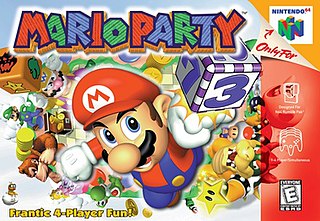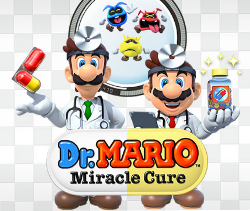
Dr. Mario is a 1990 puzzle video game developed and published by Nintendo for the Nintendo Entertainment System, Famicom, and Game Boy. It was produced by Gunpei Yokoi and designed by Takahiro Harada. The soundtrack was composed by Hirokazu Tanaka.

Mario Party is a party video game developed by Hudson Soft and published by Nintendo for the Nintendo 64. It was released in Japan on December 18, 1998, in North America on February 8, 1999, and in Europe and Australia on March 9, 1999. The game was targeted at a young audience. Mario creator Shigeru Miyamoto served as development supervisor. It received mostly positive critical reviews for its multiplayer mode, concept, and music; disapproval of its slow pacing; and mixed reviews of its graphics. It is the first installment in the Mario Party series, followed by Mario Party 2 in 1999 for Nintendo 64. The game received its first official re-release on the Nintendo Switch Online + Expansion Pack on November 2, 2022.

Mario Party 2 is a 1999 party video game developed by Hudson Soft and published by Nintendo for the Nintendo 64. The second game in the Mario Party series, it was released in Japan in December 1999 and worldwide in 2000. The game received mostly positive reviews, who praised the improvements they made to the original, the multiplayer and minigames, but criticized the lack of originality, while graphics received a better but otherwise mixed response.

Mario Party 5 is a party video game developed by Hudson Soft and published by Nintendo for the GameCube. It is the fifth installment in the Mario Party series and the second game in the series to be released for the GameCube. It was first released in North America and Japan in November 2003, followed by Europe a month later. The game is set in the fictional Dream Depot, consisting of seven game boards. The single-player "Story" mode involves the player winning multiple games against the Koopa Kids to prevent Bowser from conquering the Dream Depot. The main multiplayer game mode consists of four characters from the Mario series playing a board game, with each board having a set theme. The game also features several minigames, which are played after every set of turns. Mario Party 5 introduces the "Super Duel" mode to the franchise, which requires players to assemble and control custom made battle vehicles which can be used in combat against other machines. The game features ten playable characters, with playable debuts to the series from Toad, Boo, and Koopa Kid.

Mario Party 6 is the sixth installment in the Mario Party series of board game-style party video games by Nintendo and is the third game in the series made for the GameCube and was released in Japan on November 18, 2004; in North America on December 6, 2004; in Europe on March 18, 2005; and in Australia on September 15, 2005. It is the first GameCube game to make use of a microphone add-on.

Dr. Mario 64 is a tile-matching action puzzle video game developed and published by Nintendo for the Nintendo 64. The game was released in North America on April 9, 2001. The game is an enhanced remake of Dr. Mario, which was originally released for the NES and Game Boy consoles in 1990, and is based around characters from the 2000 Game Boy Color game Wario Land 3. The game's soundtrack was composed by Seiichi Tokunaga, featuring arrangements of classic Dr. Mario tunes and new compositions.

Tetris & Dr. Mario is a 1994 puzzle video game compilation published by Nintendo for the Super Nintendo Entertainment System. It contains enhanced remakes of Tetris (1989) and Dr. Mario (1990), which were originally released for both the Nintendo Entertainment System and Game Boy in North America. Both games include split-screen multiplayer and a "Mixed Match" mode that transitions between the two games.

Dr. Mario Online Rx, stylized as Dr. Mario Online ℞ and released in PAL regions as Dr. Mario & Germ Buster, is a puzzle video game starring Dr. Mario. It was one of the WiiWare launch games in Japan, Europe, and Australia, and was released in 2008 on March 25 for Japan, on May 20 for Europe and Australia, and for North America on May 26.

Dr. Mario Express, known in PAL regions as A Little Bit of... Dr. Mario, is a Mario action puzzle video game published by Nintendo. The game was released as a DSiWare title for the Nintendo DSi platform. Dr. Mario Express was released as a launch title for the DSiWare service in Japan on December 24, 2008, and was released in both North America and PAL regions in 2009. The game was developed by Arika, which had also created Dr. Mario Online Rx for WiiWare.

The Year of Luigi was the 30th-anniversary celebration of the fictional character Luigi. He was created by Japanese video game designer Shigeru Miyamoto for the 1983 arcade game Mario Bros. and has appeared frequently as a minor or supporting character in the Mario franchise since. Due to Nintendo's decision to develop Luigi's Mansion: Dark Moon and Mario & Luigi: Dream Team at the same time, they declared 2013 the Year of Luigi. According to Mario creator Shigeru Miyamoto, Nintendo staff members also had the urge to develop games focused on Luigi, and considered the character underrepresented compared to Mario. It was announced via Nintendo Direct on February 14, 2013, by Nintendo CEO Satoru Iwata and ended on March 18, 2014.

Dr. Luigi is a 2013 puzzle video game developed by Arika and Nintendo SPD, and published by Nintendo for the Wii U console. It is the sixth game in the Dr. Mario series and is part of the larger Mario franchise. The player must clear a field of invading viruses using pill capsules to eliminate them, in a tile-matching fashion. The game offers four modes: "Operation L", which utilizes L-shaped pills; "Virus Buster", using the Wii U GamePad and touchscreen; "Retro Remedy" with standard Dr. Mario gameplay; and local and online multiplayer options, online utilizing the soon to be defunct Nintendo Network Service.

Dr. Mario: Miracle Cure is a puzzle video game for the Nintendo 3DS. It was released in Japan on May 31, 2015 and North America, Europe, and Australia on June 11, 2015.

Mario Tennis: Ultra Smash is a 2015 tennis video game in the Mario Tennis series developed by Camelot Software Planning and published by Nintendo for the Wii U, released internationally in November 2015, and released in Japan in January 2016. It is the first Mario Tennis game to feature simultaneous online worldwide multiplayer. The game received mixed reviews from critics; it was criticized for a lack of additional modes, its smaller character roster than prior entries, and a perceived lack of enough innovation, with many deeming the game to be inferior to previous installments in terms of content, although its visual presentation, gameplay, and multiplayer were praised.

Mario Party: Star Rush is a party video game developed by NDcube and published by Nintendo for the Nintendo 3DS. It is the fourth handheld game in the Mario Party series. The game features a new party mode known as Toad Scramble which deviates from the normal Mario Party series in its removal of turn-based gameplay in favor of the ability to move at will, simultaneous with other players, and without set paths on the game board.

Super Mario Run is a 2016 side-scrolling platform video game developed and published by Nintendo for iOS and later Android. It is Nintendo's first mobile game that is part of one of the company's long-running and major franchises.

Nintendo, a Japanese home and handheld video game console manufacturer and game developer, has traditionally focused on games that utilize unique elements of its consoles. However, the growth of the mobile gaming market in the early 2010s led to several successive fiscal quarters where they were running at a loss. Nintendo, led by president Satoru Iwata at the time, developed a strategy for entering into the mobile games market with development partner DeNA, as a means of introducing their franchise properties to mobile players with a goal of bringing them to buy Nintendo's consoles later. Since 2015, Nintendo has internally developed a number of mobile games, while also publishing games with other developers, including games outside of the initial DeNA partnership. Several of them have entered the top-downloaded games list on the iOS App Store and Google Play stores, earning over US$100 million in revenue in total.

Mario Kart Tour is a 2019 kart racing mobile game developed by Nintendo EPD and published by Nintendo for iOS and Android devices. The game was announced in January 2018 and was released on September 25, 2019, on Apple App Store and Google Play.

Super Mario Party is a party video game developed by NDcube and published by Nintendo for the Nintendo Switch. The eleventh main entry in the Mario Party series, the game was described as a "complete refresh" of the franchise, bringing back and revitalizing gameplay elements from older titles while also introducing new ones to go along with them. It was released worldwide on 5 October 2018 and sold 1.5 million copies by the end of the month. As of December 31, 2023, the game has sold more than 20.34 million copies worldwide, making it one of the top ten best-selling games on the system. Mario Party Superstars, a game featuring maps remastered from earlier entries and a return to the original formula, was released in 2021.

Super Mario Maker 2 is a 2019 side-scrolling platform game and level creation system developed and published by Nintendo for the Nintendo Switch. It is the sequel to Super Mario Maker and was released worldwide on June 28, 2019. The gameplay is largely retained from that of its predecessor, in which players create their own custom courses using assets from various games across the Super Mario franchise and share them online. Super Mario Maker 2 introduces new features and course assets, including a single player story mode and new level assets based on Super Mario 3D World.

The Piranha Plant, known as Pakkun Flower in Japan, is a fictional plant species from Nintendo's Mario franchise media. It usually appears as a leafy green stalk topped with a white-spotted red or green globe, with a maw lined with sharp teeth reminiscent of piranhas. Piranha Plants are typically portrayed as tethered enemies which emerge from green-coloured "warp pipes" scattered throughout the game world that player characters must evade or overcome, though multiple subspecies with different abilities as well as physical attributes have appeared in various titles: some may simply stick up from the ground, and in some cases even walk freely on its own roots.


















